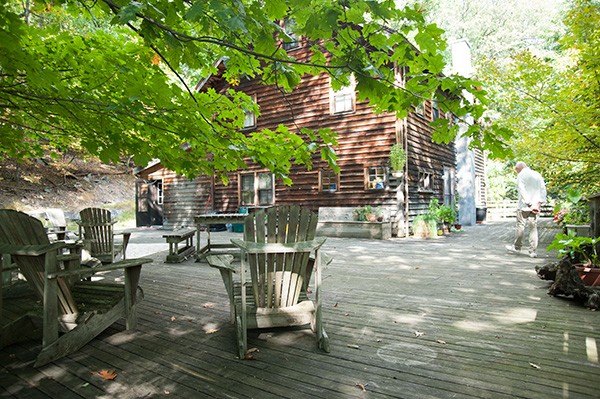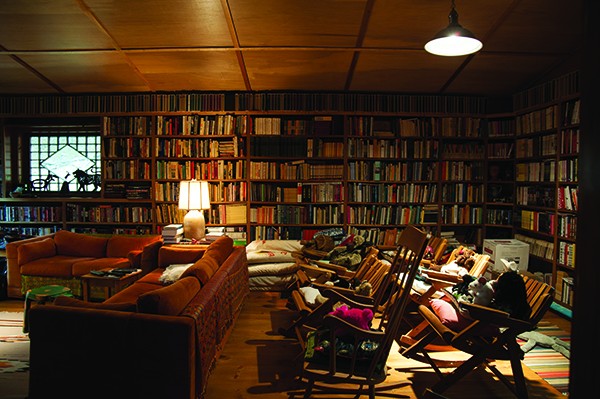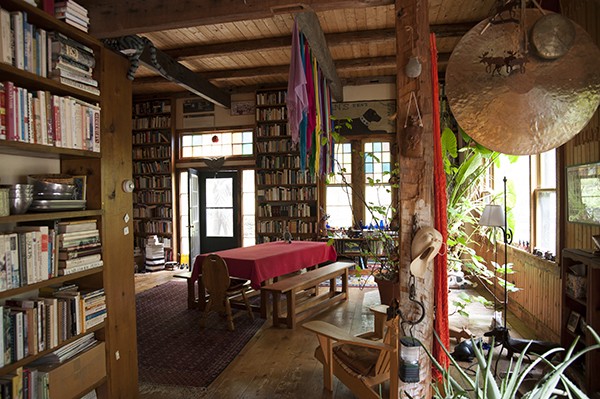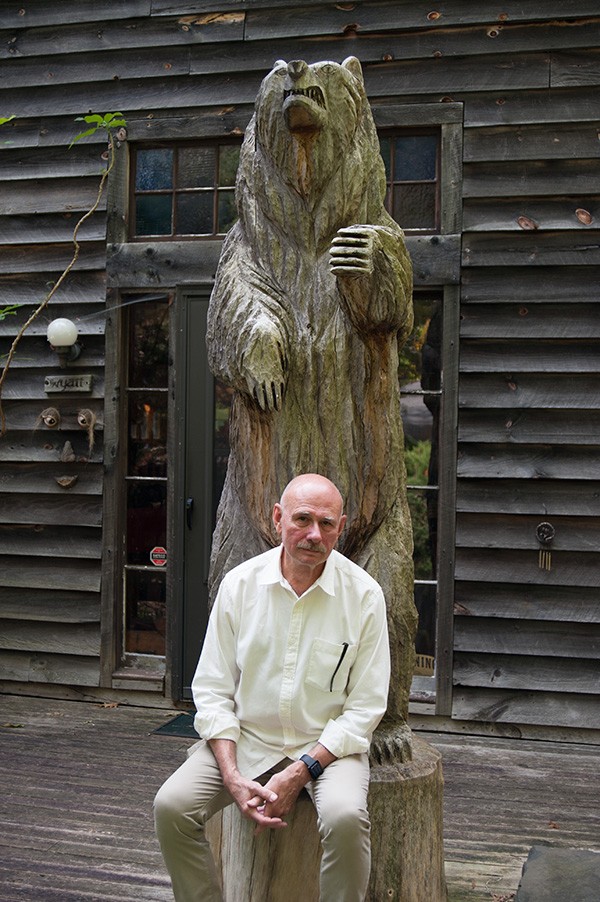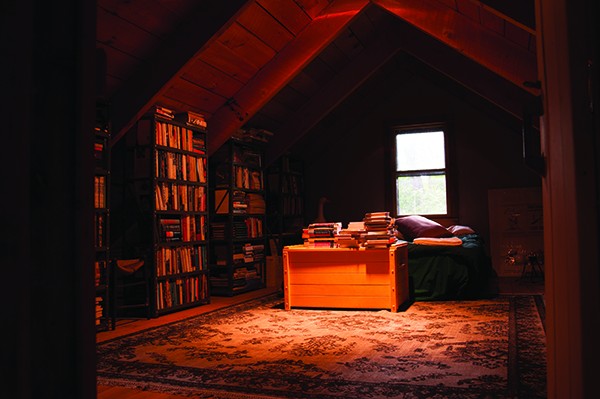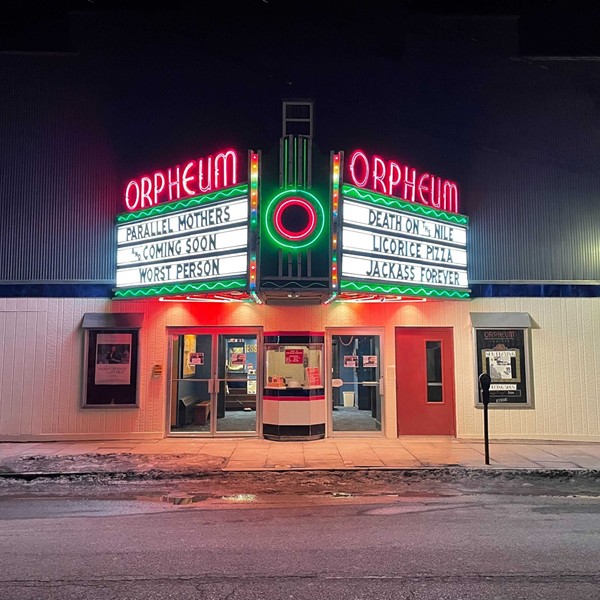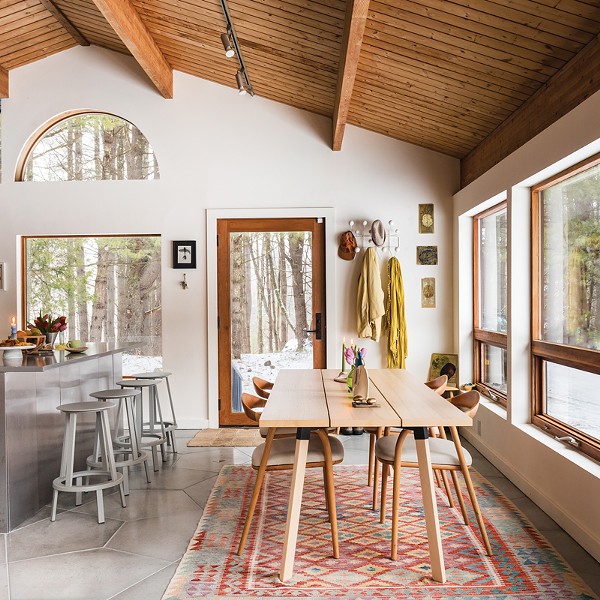The house was quiet and the world was calm.
The reader became the book; and summer night
Was like the conscious being of the book.
The house was quiet and the world was calm.
The words were spoken as if there was no book,
Except that the reader leaned above the page,
Wanted to lean, wanted much to be
The scholar to whom his book is true, to whom
The summer night is like a perfection of thought.
The house was quiet because it had to be.
—Wallace Stevens ("The House Was Quiet and the World Was Calm")
Halfway up the mountain above the Woodstock village green is a barn-style home guarded by a seven-foot-tall wooden bear. The house rambles and wanders, offering surprises that keep a visitor off balance in a delightful way. It is a place that reflects its current owner's personality as few houses do. It's also a house he didn't really want.
The house began its life as a classic Woodstock handmade house, a structure put together with good intentions, lots of imagination, and little regard for practicality. The kitchen is a tucked into a corner like an afterthought. Many of the windows looking into the woods are not made to open. Drafts blow in winter. Steps don't proceed rationally, but appear at odd intervals or in strange places. It was one of several homes built by Thom Roberts, better known as Humpty Dumpty, founder of the venerable children's publication Humpty Dumpty Magazine. The story of its eventual purchase by Robert B. Wyatt, a publisher and author, is, as befits a fiction connoisseur, a fine tale. Wyatt's 2014 book, Adventures of a House and Its Books, is a loving homage to the home that he reluctantly adopted.
A small, yellowed classified ad from the Woodstock Times circa 1978, now framed on the kitchen wall, begins the story:
NEW-OLD HOUSE
Stained glass windows from a 19th century RR sta., handhewn beams from a 18th century farmhouse, magnificent view...Walls are palstered [sic]& wainscoated...We're finishing the house now....$87,500. Negotiable.Wyatt saw the ad and guessed the seller was his old friend Thom "Humpty Dumpty" Roberts. He'd helped Roberts and his wife demolish a building to construct another similar house in Woodstock years before. To meet Wyatt today—a trim, well-dressed gentleman with many pairs of very clean sneakers, is to understand what a strange event that demolition must have been.
Years went by and the friends lost touch. But that 1978 classified ad convinced Wyatt that the house being advertised was another project conceived by Humpty Dumpty.
A phone call proved him correct. But this time, Roberts's situation was desperate. He had a new wife and three children. He needed to sell. He was broke. He couldn't sell it unfinished. After a long evening of intoxicating substances and friendly banter, Wyatt agreed to loan Roberts the money to finish the place.
"I was trapped into buying this house by my good nature," Wyatt confesses. "I didn't have much money but I loaned him $5,000. And I knew I would never see that five thousand dollars again if I didn't give him $75,000 more."
He didn't particularly like the place. He knew he didn't need it. He arrived at his new country home on Valentine's Day, 1979.
"I broke into tears right there in the living room while a rainstorm raged outside. What had I done? I lived in New York City. I worked in New York City. I didn't have a car. There was no stove, no beds. And now I had a mortgage and no furniture."
A Private Library
What he did have were books. Lots of books. Wyatt's career has been about books, from his job managing the paperback section at Doubleday Books' New York City store, to editorial director positions at Avon, Delacorte, and Ballantine Books. He had his own imprint at St. Martin's Press, and won awards from Publisher's Weekly and Literary Market Place. Wyatt's author list is a who's who of first novels issued at various houses: Russell Banks, Anita Diamant, Douglas Preston, William Kotzwinkle, and Norma Fox Mazer, to name few.Not surprisingly, Wyatt has amassed an impressive collection of books. He was downsizing his home in the city. He had a lot of books with very little space. So he brought them upstate. "And they piled up and they piled up and they piled up," Wyatt says. "So I started building more bookshelves."
Beyond a sitting room next to the kitchen (both lined with books) is an extra room—a large media room, also lined with books. "I built that room for the books," Wyatt admits. "Everything is the books."
It's an eccentric home theatre, with a large television and rows of hardwood chairs inhabited by an audience of stuffed animals. Wyatt's sense of humor is very much in evidence throughout the house, where rubber rats share shelf space with more highbrow ephemera. But the foundation beneath the fun is constant: books.
Wyatt's books are very precisely ordered, categorized, and alphabetized by genre, author, and subject.
"You have to remember when I got off the boat from Oklahoma, I worked in the Doubleday Bookstore for two years. I developed a bookseller's sense of order. I shouldn't brag, but I don't think there's a misplaced book in this house." Wyatt then crosses his fingers and bursts out laughing.
One upstairs guestroom hosts "fiction, A through C, and children's books." The second has "fiction, C through H." And if you're wondering, yes, there are books stacked in the bathroom.
The Quiet Life
The master bedroom, a huge, airy space with a long plank workspace beneath the window, is full of carefully organized periodicals. Beside the workspace are pages of quotes, inspiring, funny, thought-provoking, or touching. The windows feature individual panes with the faces of Wyatt's favorite authors. (He has a particular soft spot for Valley of the Dolls author Jacqueline Susann.) Up the steps within the master bedroom is another loft bedroom, a little attic cubby where Wyatt says he likes to relax and think. The walls are lined with books and the stacks continue on the chest at the foot of the bed.Plants, both indoors and out, grow with wild abandon, apparently thriving on benign neglect. Wyatt takes particular pride in this summer's massive chia plants, leaning delicately against the corner of the house.
Surrounding the house is a massive deck perfect for entertaining, but Wyatt prefers the quiet life. If he is feeling particularly friendly, Amanuensis Bear (the name of the massive mascot by the front door) will be holding a sign welcoming you by name when you visit. (An amanuensis, if you have forgotten, is a literary or artistic assistant, one who copies manuscripts and takes dictation.)
Wyatt is most often found in his kitchen, which he sadly admitted is really not up to the amount of work he does there. Wyatt enjoys experimenting with recipes, though he's been known to forget key ingredients. Culinary failures are shared with the creatures who live in the woods outside. Furniture is where furniture needs to be, but there isn't a sense of careful decoration.
"Living with books, they sort of osmotically get into your body. I don't know if it's a healthy or a not-healthy cancer. There are only four things that are important to me—only four: reading, writing, cooking, and friendship. That's all I need."
Wyatt's Woodstock book house has proven to be the perfect spot to cultivate all those interests. It is, as the Wallace Stevens poem tacked to Wyatt's wall describes, quiet. And when you're in it, the world is calm—the perfect spot for reading.







